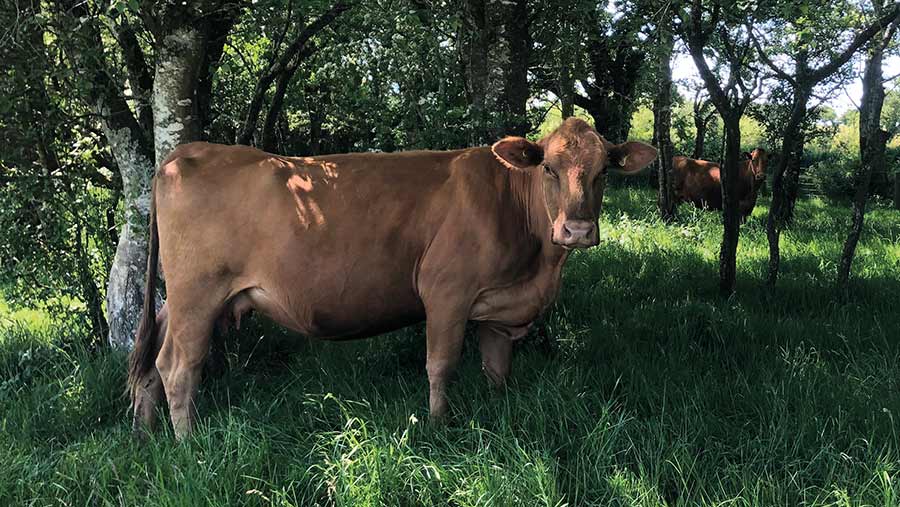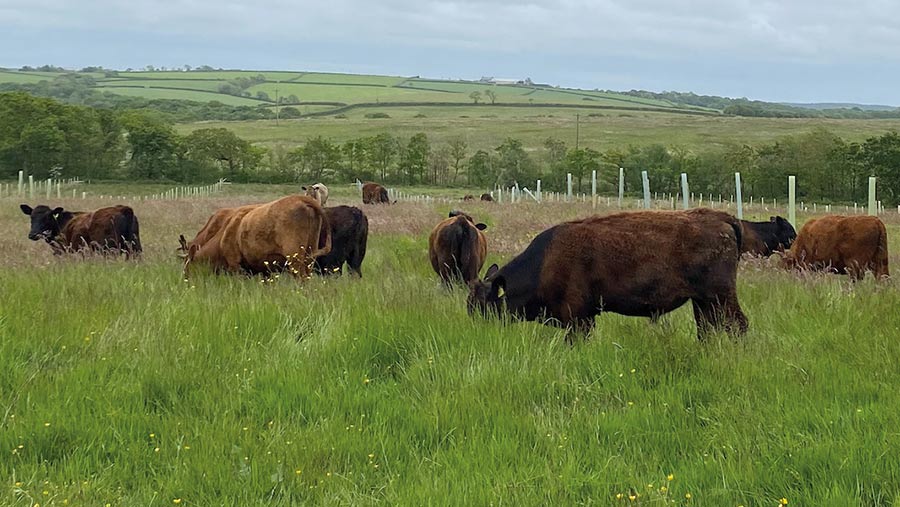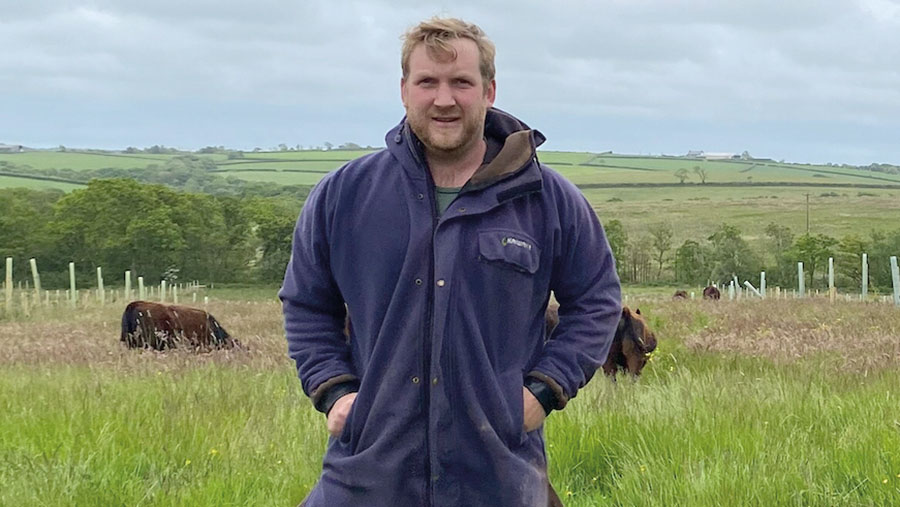How silvopasture can help with heat stress
 © Henry Andrews
© Henry Andrews When farm environment adviser Luke Dale-Harris set about creating the Devon Silvopasture Network, helping farmers find ways to manage heat stress in their livestock was central to his thinking.
There had been a lot of talk about planting trees to combat climate change, he says. But much of it involved replacing grassland with trees.
“Rather than planting across all our pastureland, I wanted to explore how trees could be factored into pastureland in a way that did not stop it being pastureland, and instead provided benefits to everyone involved.”
See also: What benefits do trees offer to livestock systems?
The network brings together seven farmers across a cross-section of sectors and systems: dairy, beef and sheep, conventional and organic, arable rotation and straight pasture.
They are trialling three silvopasture designs – shelterbelts, regularly spaced alley planting, and wood pasture.

© Bryony Andrews
Partners in the network are Farming and Wildlife Advisory Group SouthWest, Innovative Farmers, Rothamsted Research, the Organic Research Centre and the Woodland Trust.
“Farmers are being given a hard time, especially beef and sheep farmers, for theoretically trashing the planet,” says Mr Dale-Harris.
“On the other hand, they are being encouraged by policymakers to do things for environmental payments. And then they’ve got increasing environmental pressures on their businesses – things like heat stress.”
How to alleviate heat stress using existing farm features
1. Enhance hedgerows for shade
Cut hedges on a long enough rotation that they can grow up to provide some shade, and select some hedgerow trees to grow into standard trees offering further shade.
2. Allow some access to woodland
Ancient woodland is likely to be damaged ecologically by grazing, but stock could have access to woodland of lower ecological value. The benefit of using woodland for shade in summer is that the risk of poaching will be quite low.
3. Revive coppice management
Coppicing understorey species in woodland, such as hazel and willow, will let more light in, encouraging more grass growth and providing browse from the coppice regrowth.
4. Plant trees along electric fence lines
When dividing fields for grazing purposes with electric fencing, consider planting a mix of trees and shrubs – like a hedge, but less densely planted – along the fence line. There is already one line of protection, so it is easy to add another on the other side.
5. Technology
No-fence technology offers huge scope for grazing shady areas that are difficult to access or fence, or to protect a particular area within a wood. However, this technology is still expensive.
Source: Luke Dale-Harris, FWAG SW farm environment adviser
The aim of the silvopasture trial is to research a range of hypothesised livestock benefits it can bring.
“We’ll be measuring soil carbon, biodiversity, sward composition and productivity, and how those things change as the canopy gets closer to closing,” he says.
“Working out where the sweet spot is – how much tree cover you can have before losing sward productivity – is going to be critical.”
Case study: Henry Andrews
Farm facts
Leworthy Manor, Pyworthy, Devon
- 50ha (125 acres) permanent pasture
- 50 suckler cows – South Devon base with Angus and Red Devon bulls
- Most stock sold as stores at 12 months
- Average daily liveweight gain 1.1kg a head a day for first 12 months
- Some heifers kept for finishing – target weight 550kg at 20 months, with 55% killout on forage-only diet
Suckler beef farmer Henry Andrews is part of the Devon Silvopasture Network. He has two silvopasture designs on his heavy clay grassland farm near Holsworthy, both planted in March 2021.

Henry Andrews between alleys of trees © Bryony Andrews
Mr Andrews’ interest in the potential value of trees and shrubs for livestock began following a difficult time on the farm.
“We were running a high-input beef system with 60 breeding cows and about 250 cattle in all,” he says. “Then, in a nine-month period, we lost a third of our cows to TB. It was quite a tough time mentally, and our whole farming model fell to pieces. We went through a year or two of not really wanting to farm anymore.”
One day, sitting at the edge of a field where some time earlier the fence had been removed for the cattle to browse among a wooded margin of oak, alder, willow and silver birch, he noticed how much more content the cows seemed and how much better the grass growth was among the trees than in the open fields.
“I did some research and found the taproots of trees go down far below the soil to bring up minerals and nutrients which the grass can’t otherwise access, then deposit them on the floor as leaf-litter fertiliser.”
It was the start of a new direction for the farm, to a very low input system working with nature. Silvopasture is part of this new approach.
Shade and shelter
The first of the farm’s two silvopasture designs is an extension of the 200x15m woodland edge where Mr Andrews had sat watching his cattle. In time the cattle will be able to graze, browse and seek shade or shelter here.
“There is often concern that if you plant trees, they will compete with the grass. But, in our existing woodland with 70% tree cover, grass growth is a lot better than in the open field,” he says.
The second area is a 6ha (15-acre) field exposed to high wind speeds from the West. There are 10 alleys of trees 20m apart. Each alley is planted with standard trees protected by shrubs, alternating with additional shrubs for future browsing.
The trees and shrubs in each alley are protected on both sides by electric fencing, creating a 2m-wide ungrazed strip.
There is a gap at either end of the field to allow for access, and the cattle are cell-grazed in the 18m between each alley, in a snaking pattern across the field.
“At the moment we have 30 youngstock in there. We’re backfencing inside the alleys as well,” says Mr Andrews.
In five years, once the trees are established, he plans to remove the fencing from one side of each row of trees and shrubs.
By doing this, the cattle can browse the shrubs and, in time, benefit from shade and shelter, while still cell-grazing.
“We’re still finding our feet a bit with stocking densities, but we’ve already improved the efficiency of this field with cell-grazing.
“My hope is that in five years’ time the trees will be providing shade, shelter, nutrients and worming properties to the cows.
I’m also hoping the trees will help improve soil structure so that we can extend the grazing season.”
Silvopasture advice and funding
The Woodland Trust’s UK-wide Trees for your Farm scheme, funded by Sainsbury’s and the PUR Project, provides one-to-one advice and heavily subsidised trees and protection. Email plant@woodlandtrust.org.uk with details of your farm business, what type of planting you are planning and the impact you hope the trees will have on your farm. Applications for planting between November 2023 and March 2024 are currently being accepted.
